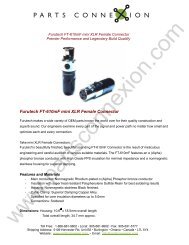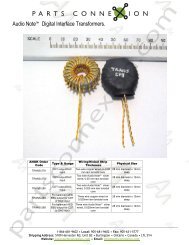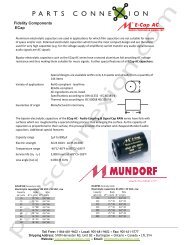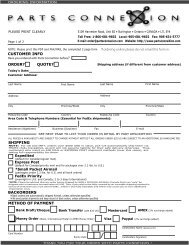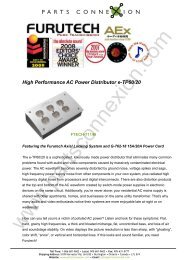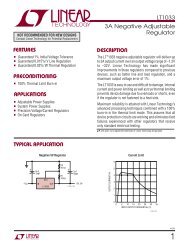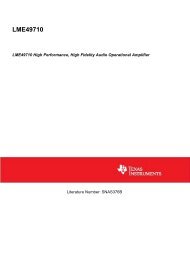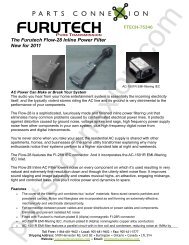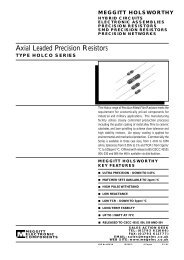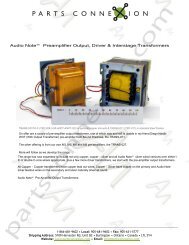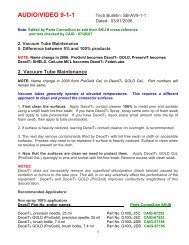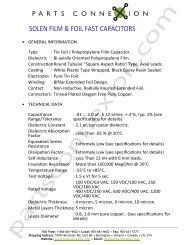LME49880 Overture E-Series Dual JFET Input ... - Parts ConneXion
LME49880 Overture E-Series Dual JFET Input ... - Parts ConneXion
LME49880 Overture E-Series Dual JFET Input ... - Parts ConneXion
You also want an ePaper? Increase the reach of your titles
YUMPU automatically turns print PDFs into web optimized ePapers that Google loves.
<strong>LME49880</strong><br />
Application Hints<br />
OUTPUT DRIVE AND STABILITY<br />
The <strong>LME49880</strong> is unity gain stable within the part’s commonmode<br />
range. Some instabilities may occur near the limit of the<br />
common-mode range. It can drive resistive load 600Ω with<br />
output circuit with a typical 26mA. Capacitive loads up to<br />
100pF will cause little change in the phase characteristics of<br />
the amplifiers and are therefore allowable.<br />
Capacitive loads greater than 100pF must be isolated from<br />
the output. The most straight forward way to do this is to put<br />
a resistor in series with the output. This resistor will also prevent<br />
excess power dissipation if the output is accidentally<br />
shorted. The internal short-circuit protection of <strong>LME49880</strong> also<br />
prevent the device from damage when the either outputs<br />
are being shorted.<br />
The effective load impedance (including feedback resistance)<br />
should be kept above 600Ω for fast settling. Load capacitance<br />
should also be minimized if good settling time is to be optimized.<br />
Large feedback resistors will make the circuit more<br />
susceptible to stray capacitance, so in high-speed applications<br />
keep the feedback resistors in the 1kΩ to 2kΩ range<br />
whenever practical.<br />
OUTPUT COMPENSATION<br />
In most of the audio applications, the device will be operated<br />
in a room temperature and compensation networks are not<br />
necessary. However, the consideration of network as shown<br />
in Figure 3 may be taken into account for some of the high<br />
performance audio applications such as high speed data conversion<br />
or when operating in a relatively low junction temperature.<br />
The compensation network will also provide a small<br />
improvement in settling time for the response time demanding<br />
applications.<br />
PSOP EXPOSED PAD PACKAGE<br />
The <strong>LME49880</strong> has an exposed pad on the bottom side of the<br />
IC package. Connect the exposed pad to pin 4 (V-) of the IC.<br />
The PCB footprint for the exposed pad should be a open<br />
polygon of copper to provide a good thermal path away from<br />
the <strong>LME49880</strong>. Use multiple vias on the exposed pad to create<br />
better thermal conductivity. Do not route traces below the<br />
exposed pad as they risk shorting to the exposed pad.<br />
300596t3<br />
FIGURE 4: <strong>LME49880</strong> Output Compensation Network<br />
SUPPLY BYPASSING<br />
To achieve a low noise and high-speed audio performance,<br />
power supply bypassing is extremely important. Applying<br />
multiple bypass capacitors is highly recommended. From experiment<br />
results, a 10μF tantalum, 2.2μF ceramic, and a<br />
0.47μF ceramic work well. All bypass capacitors leads should<br />
be very short. The ground leads of capacitors should also be<br />
separated to reduce the inductance to ground. To obtain the<br />
best result, a large ground plane layout technique is recommended<br />
and it was applied in the <strong>LME49880</strong> evaluation<br />
board.<br />
300596r5<br />
FIGURE 3: <strong>LME49880</strong> Output Compensation Network<br />
www.national.com 8



